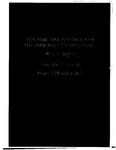ACTIVISM, ART PRACTICE AND THE VULNERABILITY OF MESSAGE
| dc.contributor.supervisor | Smiles, Sam | |
| dc.contributor.author | Darbyshire, Ralph | |
| dc.contributor.other | Faculty of Arts, Humanities and Business | en_US |
| dc.date.accessioned | 2011-08-26T15:06:04Z | |
| dc.date.available | 2011-08-26T15:06:04Z | |
| dc.date.issued | 2011 | |
| dc.identifier | 10096377 | en_US |
| dc.identifier.uri | http://hdl.handle.net/10026.1/558 | |
| dc.description.abstract |
This research project uses practical work and a supporting text to explore activism in contemporary art. Its chief concern is to consider what constitutes an activist art practice by clarifying the terms of engagement of such work. In the textual part of this submission the production of recent and contemporary artists who are widely presumed to make activist art has been examined. Their different approaches have been identified and critical evaluations of them have been offered. The artists under review include Christian Boltanski, Agnes Denes, Hans Haacke, Thomas Hirschhorn, Edward Kienholz, Doris Salcedo, and others. The analysis differentiates between them on the basis of their success as activist artists. Broadly speaking, two major strands of effective activism are identified. The first provides the audience/spectator with an understanding of their complicity in situations which are not clear-cut, where ethical standards are in conflict and where the perception of issues and solutions remains occluded. This kind of activism refuses any kind of programmatic clarity and encourages its viewer/recipient to acknowledge their moral and epistemological confusions. Although it may make use of local and particular circumstances and events its overall message transcends them and it is theoretically transportable to other sites without loss of impact. The second strand of activism is designed to work with maximum impact in highly localised situations, drawing on very particular shared experiences in tightly circumscribed locations. This kind of activist art, unlike the first, cannot be removed from its exact social and political context without loss of meaning. It is the contention of the thesis that successful activist art, in either strand, is very difficult to achieve and that much of what passes as activist art is flawed, either because it is crudely propagandic or because it is too opaque for the public to respond to it. The critical framework outlined in the textual submission is the matrix within which the practical element of this submission should be considered. The work submitted for examination extends the idea of activism as a means of making tangible the political and ethical confusions of everyday life. It is designed to be eye-catching , alluring and domineering, using scale, materials and iconography to encourage close inspection. The practical work offers the spectator a sculptural environment in which news reports, memories, moral beliefs, cultural stereotypes and historical markers are put in play. It is intended to provoke reflection, to linger in the memory, precisely because it cannot be categorised or assimilated easily as a simple message. | en_US |
| dc.language.iso | en | en_US |
| dc.publisher | University of Plymouth | en_US |
| dc.subject | Activism | en_US |
| dc.title | ACTIVISM, ART PRACTICE AND THE VULNERABILITY OF MESSAGE | en_US |
| dc.type | Thesis | |
| dc.identifier.doi | http://dx.doi.org/10.24382/3353 |
Files in this item
This item appears in the following Collection(s)
-
01 Research Theses Main Collection
Research Theses Main


